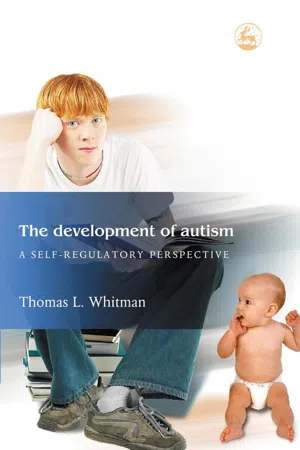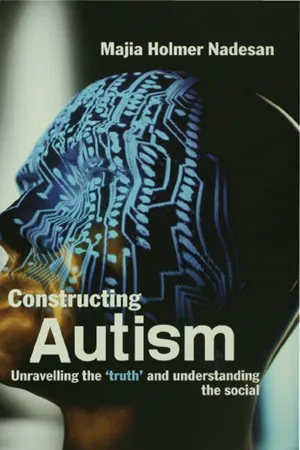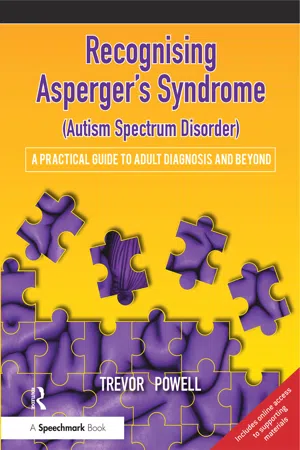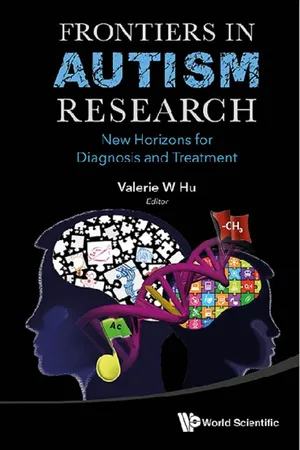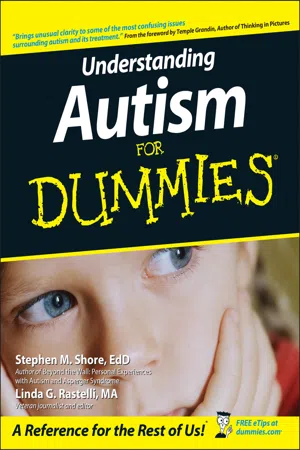Psychology
Biological Explanations for Autism
Biological explanations for autism suggest that genetic and neurological factors play a significant role in the development of the condition. Research has identified specific genes and brain abnormalities associated with autism spectrum disorder (ASD). These biological factors are believed to contribute to the atypical social, communication, and behavioral patterns observed in individuals with autism.
Written by Perlego with AI-assistance
Related key terms
6 Key excerpts on "Biological Explanations for Autism"
- eBook - ePub
The Development of Autism
A Self-Regulatory Perspective
- Thomas L. Whitman(Author)
- 2004(Publication Date)
- Jessica Kingsley Publishers(Publisher)
Theories of autism can be typically subdivided into those that are psychological or biological. Psychological theories specify the role that different processes, such as those involving the attention or the sensory system, play in symptom development. In contrast, biological theories emphasize how various factors such as genes, neurochemical processes, neurological structures, and environmental toxins influence symptom formation. Ideally, psychological theories should be consistent with what is known biologically about autism. Conversely, biological theories should be consistent with what is known psychologically.A variety of theories of autism have been proposed. Many of these theories are quite descriptive and not very formalized in their presentation. Most theories of autism are quite speculative and in need of empirical verification. Moreover, most theories are narrow in scope, focusing on only a few of the symptoms associated with autism. Theory formulation in the area of autism is particularly difficult because of the number and heterogeneous nature of the symptoms. At present, it is not clear which symptoms of autism are primary, that is, are a critical part of an early process leading to other symptoms. Ideally a comprehensive theory of autism should emphasize how biological, psychological, and environmental factors can work in conjunction to explain the development of autism. Moreover, to be really useful, a theory of autism should specify how biological and/or psychobehavioral interventions can be structured to address the underlying causes of autism so as to prevent or ameliorate the symptoms associated with this disorder. Although there is empirical support for some theories of autism, no one theory has emerged that has gained broad acceptance. Because of the rapidly increasing scientific interest in autism, it is likely that the theoretical landscape will change dramatically in the next decade.In this chapter current theories of autism are briefly reviewed. Special attention is given to social–environmental, psychological, and biological theories. The social–environmental theories focus on how the family and other social factors influence the development of autism. The psychological theories emphasize the importance of cognitive, language, sensory integration, or arousal/activation processes. The biological theories discuss the role of genetic, neurostructural, neurochemical, and environmental factors. Our discussion begins with an examination of theories that emphasize the influence of the social environment on the development of autism. - eBook - ePub
Constructing Autism
Unravelling the 'Truth' and Understanding the Social
- Majia Holmer Nadesan(Author)
- 2013(Publication Date)
- Routledge(Publisher)
Complementing the search for the genetic origins of autism is another research approach I describe as “autism brain science.” In contrast to the purely genome-driven approach described immediately above, those researchers who conduct “autism brain science” presume that the expression of autistic symptoms traces back to specific neurological abnormalities explainable in terms of genetic errors, gene alleles, or environmental insults. Autism brain science thus faces the challenge of establishing direct equivalences between the phenotypic expression of autism and specific neurological characteristics and then explaining these equivalences in terms of genetic or environmental causal pathways. Thus, autism brain science typically presupposes a linear, unidirectional relationship across neurological abnormalities and the expression of autistic symptoms. The role of the social environment in shaping autistic symptoms has little to no significance in this model. The challenges associated with such linear relationships will also be explored throughout this chapter. I now turn to a more detailed discussion of the scientific quest for discovering the biological “origins” of autism.Autism: the search for causal agentsAn explicit disavowal of the psychoanalytic formulation of autism as rooted in the mother-child relationship motivated the project of defining autism strictly as an organic disorder. Bernard Rimland, a PhD whose son is autistic, helped spearhead the movement in the United States to understand the disorder from a biomedical perspective. Understood from this framework, autism is loosely conceived as a disease or set of diseases caused by underlying genetic errors or variant alleles engendering a variety of neurological and/or physiological conditions believed to cause the development of autism. Across approaches, observable “autistic” behaviors and cognitive deficits are thus believed to be epiphenomena of the underlying organic disorder(s). In order to understand how the biogenetic perspective constructs autism it is first important to understand how research is conducted in the search for the biomedical markers of autism.Contemporary autism research takes a variety of approaches to discover specific biological markers for the disorder. Perhaps the most publicized approach focuses on identifying a distinct autistic genotype or genotypes across autistic populations. Another related approach explores the relationship between autistic symptoms and other medical conditions in order to understand how biomedical conditions may give rise to the disorder. This second approach does not necessarily construe autism as a distinct disease characterized by exclusive biological markers but it does point to the possibility of the existence of specific gene defects or gene alleles producing biological susceptibilities to agents that can catalyze the disorder. Finally, another popularized approach uses neuroimaging techniques to identify abnormalities in the brain anatomy and brain development of autistic people. Explanations for observed brain abnormalities point to either genetic errors and/or environmental insults suffered early in the prenatal or post-natal environment. Accordingly, I organize my discussion of the search for causal agents by looking at three research trends: - eBook - ePub
Recognising Asperger's Syndrome (Autism Spectrum Disorder)
A Practical Guide to Adult Diagnosis and Beyond
- Trevor Powell(Author)
- 2017(Publication Date)
- Routledge(Publisher)
Chapter Two Theories and facts about autism and Asperger’s syndrome1 What we know
We recognise that autism itself is a highly complex neurodevelopmental condition and that the causes too are complex and poorly understood. In this chapter we will look at what we know, including some of the facts and theories.- It is a neurodevelopmental biogenetic condition, which means it is something a person is born with.
- People with autism have brains that are wired differently which affects the way information is processed in the brain.
- We know that autism is not caused by bad parenting; it is definitely not the parents’ fault. Theories years ago around inadequate parenting were very damaging, misguided and misleading.
- It is a lifetime condition although people change and develop new skills and may move out of the diagnostic range. Talking about a ‘cure’ is not helpful.
- It is highly hereditary with strong genetic links and runs in families, but we do not know which particular genes are involved.
- It is a spectrum condition, so it is on a continuum or range from mild to severe. Some would argue that it tails off in its milder form into personality characteristics. It is not a straightforward spectrum, but one which has different constellations and many diverse forms.
- We don’t really know much about what causes it, but we do know there is no link between the onset of autism and vaccination.
- Gender ratio: It is more common in males than females, although the estimated ratio has gone down from 10:1 to 3:1 in the past few decades.
2 Theory of mind
Figure 2.1 : Theory of mindThe theory of mind (ToM), sometimes referred to as ‘mindreading’ or ‘mentalising’, refers to a person’s ability to recognise and understand the thoughts, beliefs, intentions, feelings and desires of others in order to make sense of their behaviour and predict what they are going to do next. Colloquially it means ‘putting yourself in somebody else’s shoes’ or reading the intention of another. This involves taking a perspective other than your own. It also involves being able to reflect on your own thoughts and feelings – to stand back and look at yourself. The theory goes back to the seventeenth-century French philosopher Rene Descartes. If a person has difficulty taking the perspective of another, they are more likely to be puzzled by the action of others, have difficulty recognising and working out the feelings of others and are likely to find people unpredictable. If a person is not able to ‘read’ another person, they are more likely to encounter misunderstandings and have greater difficulties resolving conflicts. For example, they might wonder why someone is looking at somebody else in a particular way or why somebody spoke in a particular way. As a consequence of this they are also more likely to have lower levels of empathy, because they have difficulty picking up the cues that somebody might be upset. Without a good ToM life can be unpredictable and very scary. - eBook - ePub
Frontiers In Autism Research: New Horizons For Diagnosis And Treatment
New Horizons for Diagnosis and Treatment
- Valerie W Hu(Author)
- 2014(Publication Date)
- WSPC(Publisher)
Modern humans live within relatively new environmental conditions, characterized by man-made housing, freeways, manufactured foods, medicines, and consumer products. With these new conditions come novel chemical exposures to our bodies. New manufactured chemicals are usually tested for immediate toxicity; however, the cumulative effects and long-term outcomes of chemical exposures on human health and the health of future generations are often not considered. While a single environmental toxicant is unlikely to be found as the definitive causal factor for autism, the potential for cumulative effects of chemical exposures during pregnancy is concerning. In this chapter, we review the evidence for a diverse array of chemical exposures having complex interactions with the human genome and epigenome as well as the potential for transgenerational effects. While most investigations of etiological risk factors in autism consider genetic versus environmental factors as separate and distinct risks, there is more likely a complex intersection of interactions. Specifically, genes can affect susceptibility to toxins, environmental factors can influence gene expression through epigenetic mechanisms, and epigenetic changes induced by environmental exposures can impact the stability of the human genome.The Complex Etiology of Autism Spectrum Disorders
Autism spectrum disorders (ASDs) are collectively defined by impaired communication, diminished social interaction, and repetitive behavior.1 As of March 2012, the Center for Disease Control estimated that 1 in 88 children were afflicted with ASDs in the United States, a rate which has increased from 1 in 150 children just ten years prior.2 Because the criteria for diagnosis of ASDs has changed multiple times since the disorder was first described by Kanner in 1943, the question of whether there has been a true rise in prevalence or simply improved ascertainment in recent years is not easily answerable.3 ,4The changing diagnostic instruments, lack of definitive laboratory tests, and socioeconomic differences in access to diagnostic centers make the search for etiologic factors for ASDs a decidedly complex problem.ASDs are considered to be highly heritable, with historic estimates above 90% based on monozygotic twin studies,5 ,6but heritability estimates are lower in more recent studies.7 A monozygotic versus dizygotic twin study suggested that shared in utero environment was a higher risk (30–80%) than genetic risk (14–67%) for ASD.8 Another strategy for twin studies is to measure autistic traits in the general population to increase sample size by considering ASDs as the extreme on a quantitative trait continuum. Analyses of autistic traits using twin studies from the general population have observed high heritability estimates (53% females, 72% males) and suggest a shared etiology of autistic traits with extreme end ASDs.9 ,10Another general population twin study highlighted evidence for a “female protective effect”, as the siblings of female ASD probands scored higher on autistic traits than the siblings of male ASD probands, suggesting a greater genetic contribution to ASD in females.11 These combined twin studies have suggested a strong genetic component to ASD risk, with additional important roles of shared in utero - eBook - ePub
- Stephen Shore, Linda G. Rastelli(Authors)
- 2011(Publication Date)
- For Dummies(Publisher)
www.brainbank.org ), which studies donated brain tissue to understand autistic behaviors, say the cause of spectrum disorders could be innate genetic anomalies or environmental insults, or trauma. Research has found abnormalities in the brains of autistic individuals, namely in several neurotransmitter systems (neurotransmitters are the chemical messengers of the brain).Researchers have found a larger overall brain size (or volume) in autistic children 12 and younger, although the parietal lobes — associated with movement, orientation, recognition, and perception of stimuli — are smaller than normal. The brain is actually often heavier in young children with autism. Also, the amygdala and the hippocampus, the memory center, are larger in autistic children but are the same size or smaller in adolescents and adults. It seems, however, that the connections are missing or not working correctly when the brain tries to process information between different local systems. Imagine that you can call your aunt in the next county, but when you try to call long distance, you can’t get a line. This gives you a small taste of what autistic people must deal with.An overgrowth of nerve connections in the brain, according to one theory, may cause the brain to become overwhelmed with neurotransmitter signals. This theory is consistent with research studies that have found that autistic babies’ heads may grow faster than normal at various points. Why would this overgrowth occur? The normal cell “pruning” process of the fetus doesn’t occur, and too many neurons exist.How does autism develop?
Why would genetic abnormalities of the brain lead to autism? This isn’t well understood, and researchers have different theories. Some researchers think of autism as a disorder of brain-circuit dysfunction. Researcher Eric Courchesne from the University of California found abnormal growth in the frontal cortexes of autistic brains; he deduced that the only normally functioning parts of the autistic brain are the visual cortex and the areas in the back of the brain that store memories. The frontal cortex is involved with sensory interpretation, which may explain why the visual cortex (responsible for visual perception) functions normally, yet autistic people seem to have visual processing (understanding what they see) issues. - eBook - ePub
Child and Adolescent Psychopathology
Theoretical and Clinical Implications
- Cecilia A. Essau(Author)
- 2012(Publication Date)
- Routledge(Publisher)
It is difficult to draw firm conclusions from the research literature on the adjustment of siblings of children with autism. A meta-analysis of research with siblings of children with mental retardation suggested that there was evidence of a small negative effect on siblings (Rossiter and Sharpe, 2001). There is no real reason to suppose that such a review of autism-specific studies would find any different. The effects of potential moderating variables are also mixed. For example, some studies have suggested that a child younger than their sibling with autism is more at risk of adjustment problems and some studies find that it is those older than their sibling with autism that are at most risk.Clinical ImplicationsThere is some argument as to the nature of the increase in prevalence of newly diagnosed cases of autism since the 1970s. There is evidence to suggest that changes in case definition and improved awareness explain much of the upward trend of rates since the 1970s (Fombonne, 2003). In addition, since the 1990s we have heard much about the possible link between the combined MMR vaccine and autism. After reviewing 32 published epidemiological surveys published between 1966 and 2001, Fombonne (2003) concedes that the available studies do not provide an adequate picture to fully explain why the incidence of autism and other pervasive developmental disorders (e.g., Asperger’s Disorder) have increased. While the cause of autism remains unidentified, and the number of new cases continues to rise, autism spectrum disorders will undoubtedly require a greater amount of financial, educational, and clinical resources over the next few years.While the major theories outlined in this chapter have gone a long way towards outlining possible sources of the deficits seen in autism, no one theory can account for all of the features of autism. While theory of mind or social orienting deficits can explain the social and communication impairments seen in autism, they cannot account for the repetitive or stereotyped behaviours that are also a feature of this disorder. Similarly, whilst executive functioning deficits and weak central coherence theory are able to explain many of the cognitive and visual characteristics of autism, they do not provide straightforward account of autism’s social and communication deficits. Furthermore, few links between theoretical accounts of autism and intervention techniques exist. Most interventions that are used with the autistic population do not seem to be based on key psychological theories. Where attempts have been made to develop therapeutic approaches based on theory (e.g., Teaching Children with Autism how to Mindread, Hadwin et al., 1997), there is not strong evidence of success. Similarly, while the TEACCH approach is often said to be loosely based on executive functioning theory, little research evidence exists to support this link. One theory that does highlight the importance of intervention is social orienting theory. Mundy and colleagues (Mundy, 1995; Mundy and Neal, 2001) believe that early intervention increases the tendency of young children with autism to process social information within a critical period. Thus, the earlier that therapeutic intervention can begin with these children, the better the chance of increasing the saliency of social communication skills. This should in turn lessen the degree of social and communication deficit (Mundy and Crowson, 1997) and if proven correct, would help explain accounts of why early intervention works better than later intervention and why more is better than less. Mundy does not however link his theory to any intervention in particular, except to say that many of the current therapies are provided within the context of a social interaction, and should thus have the desired effects.
Learn about this page
Index pages curate the most relevant extracts from our library of academic textbooks. They’ve been created using an in-house natural language model (NLM), each adding context and meaning to key research topics.
